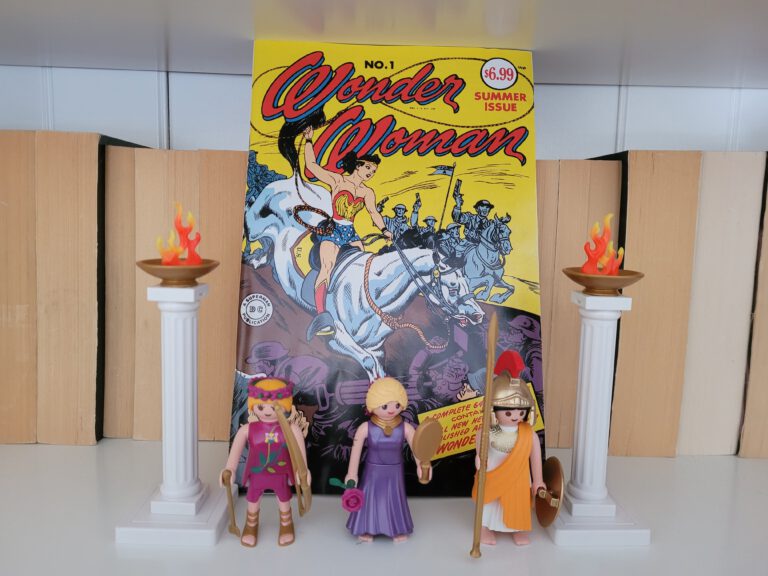Dies Optimus – A Latin Graphic Novel by Ace Chisholm
Preliminary note by Michael Kleu:
Ace Chisholm recently won a foreign language graphic novel contest organised by the Language Learning Resource Center (LLRC) of the Loyola University Chicago. After I had read a newspaper article about Ace and her graphic novel I decided immediately to contact her, since the first-year Latin student wrote the comic in Latin. Furthermore, the story is about a young harpy and fits therfore perfectly in my project. Thus, I am more than happy that Ace was interested in presenting her work on my blog. You may read or download the graphic novel here. Let’s now listen to Ace and the development history of „Dies Optimus“:
Ace Chisholm’s Development & Process Description:
The Department of Modern Languages and Literatures at Loyola University Chicago hosted a foreign language graphic novel contest with the prompt, “The best day of my life!” A short email exchange assured me that Latin, despite being a Classical language, would be allowed. Because I was going to be writing the dialogue in Latin, I decided to use characters that would be expected to speak Latin, and so I designed Alcedinosta, a young harpy (a creature from Graeco-Roman mythology), and the story developed as I drew her. I knew that I was going to be drawing whatever characters I came up with quite a bit and with a limited amount of time before the submission deadline, and so Alcedinosta began as a simple circle and triangle.
While I was working on her design, I considered how other characters would interact with her, and knowing that Roman culture was biased toward men, I wanted to give her some ambiguity in gender so that it would be fitting for the other characters, Roman soldiers, to mistake her for a boy. As a result, she ended up bald and with her wings wrapped around her, covering herself rather than being exposed as harpies typically are described. This became a running joke throughout the story as the soldiers fail to recognize her as a harpy despite several hints that she drops.
Once I had settled on Alcedinosta’s design, I decided to have only one character that would interact with her the most, and so I drew what became Gaius, a friendly Roman soldier that would be the instrument of “the best day of [her] life.” His design grew out of an afternoon of doodling various iterations of how I remembered the main character of Gladiator (2000) until he looked friendly enough to talk to a young harpy.

It was only after I had drawn both of these characters that I opened the notes app on my phone to type a script of the comic in English and closed my eyes to create the story. I prompted myself with questions while constructing scenes in my head: “What is a great day for a young mythical monster with soldiers on her island? Positive interactions with the exciting, friendly strangers. Why are the soldiers friendly? One is reminded of his children and misses them. He should invite her to hunt with them, like he would with his son, perhaps. What would prompt her to say the phrase ‘best day of my life’? Integrate it in a thank you for a gift or a departure. I imagined how the story played out with these questions and my own responses, and when I was satisfied, I typed it all down.
When I was done with typing the dialogue and actions, I divided the lines into reasonable chunks for each page, imagining a very basic structure for each to determine where to make breaks for page changes. I created a second script, this time in Latin, and then began actually putting pencil to paper. I spent a day or two storyboarding at various cafes, in which I played around with different layouts for the pages, varying the placement of panels and sketching out basic shapes for characters and text bubbles.
Back in my dorm, I took a picture of each page, opened them in my drawing program, and digitalized them. The next couple days were devoted to sketching everything with more detail and the next couple to lining. I completed the coloring last and then entered the text by typing it into word, copying and pasting it into the program, and resizing as needed. Just before exporting, I applied a watercolor texture to each page for the sake of visual interest. I deemed them complete, saved them to a flash-drive, and visited a FedEx to print the final product.
Afterword by Michael Kleu:
You may read or download the Latin graphic novel here.
- Doctor Who trifft Sokrates und Platon im antiken Athen: The Chains of Olympus (Comic, 2011–2012) - 31. August 2024
- Die Rezeption mittelalterlicher Geschichte(n) in Peter S. Beagles „Das Letzte Einhorn“ - 16. Juli 2023
- Römische Arenen und Wilder Westen: Jasmin Jülichers „Stadt der Asche“ - 4. Oktober 2022







